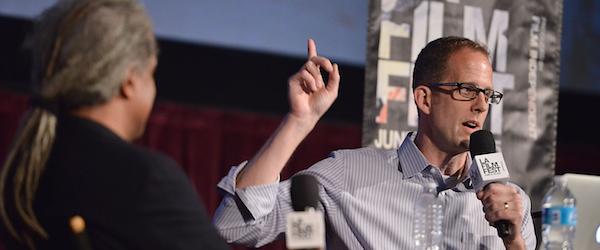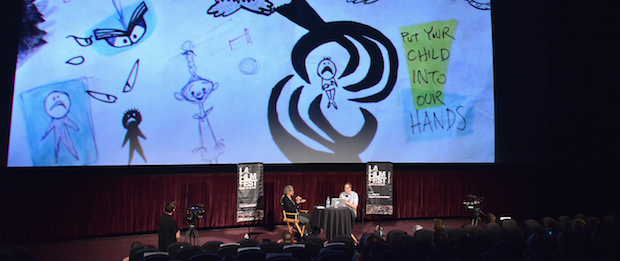Earlier this week, as part of the Los Angeles Film Festival’s special presentation of Disney-Pixar’s new film Inside Out, writer-director Pete Docter (Monsters Inc., Up) gave a master class full of anecdotes from his 20-plus years at Pixar. Doctor regaled the audience with stories of his beginnings as an animator (as a kid, he didn’t think he could draw), his first encounter with Steve Jobs (that day, Jobs laid off half the Pixar staff), and his admiration for The Muppets (For Inside Out, he even cast Muppets luminaries Frank Oz (Fozzie Bear and Miss Piggy) and Dave Goelz (Gonzo), reuniting them on screen for the first time in 16 years). But the most fascinating part of his talk was when took us inside the “brain trust room” and discussed pivotal moments in the creation of some of Pixar’s most memorable films. Here are three lessons we learned from Docter’s talk. To outsmart the audience, you have to outsmart yourself In the early ‘90s, Pixar wasn’t the high-powered giant that it is today. “It felt like a bunch of guys just doing it for fun in their garage,” said Doctor. He also described as a “shared brain experience” between himself, Toy Story director—now Pixar CCO—John Lasseter and Pixar brain trust members Andrew Stanton (Finding Nemo, Wall-E) and Joe Ranft (writer of Toy Story and A Bug’s Life writer and co-director of Cars). “I remember John saying, Buzz should have some sort of catch phrase like, ‘To Infinity…’ And I said, ‘And beyond!’ Or maybe it was vice-versa, I don’t remember because it was such a shared brain at that point.” But it wasn’t all breezy bursts of inspiration. Docter said at one point in the process the four of them were really patting themselves on the backs for their genius in having Sid, the toy-torturing devil child next door, give Woody the match that would eventually allow our cowboy hero to light the rocket strapped to Buzz and fly them both back to Andy. “What we found was people kind of saw it coming,” said Docter. “And so with no real idea of how we would solve it, Andrew just said, ‘Let’s have a car drive over it and the match goes out.’ And now the whole audience is like, ‘What!? How are they going to get out of this?!’” The answer, of course, was having Woody light the match using sunlight focused through the lens of Buzz’s helmet. Docter pointed out that the idea had already been set up in the scene when Sid burns Woody’s hand with a magnifying glass. “So that idea was in your head as something that could work,” said Docter. “Even though it’s impossible with a plastic helmet.” On the hunt for a universal story, first look for a personal one For Docter, the initial idea for his first project as director came easily. “I knew that there were monsters under the bed in the same way that we knew that our toys come to life when we leave the room.” But finding the rest of the story that would eventually become Monsters, Inc. proved trickier. “When the film started to come together people were bored by it,” said Docter. “They didn’t really understand what the film was about. ‘What do you mean,’ I said, ‘It’s about monsters!’” Docter said that what those critics were getting at was the deeper meaning. What was the film really about? “At about this time, my wife and I had our first kid,” said Doctor. “That was an amazing experience. It changed everything for me. And I had been working in, and loved animation. I couldn’t wait to get to work. I’d spend hours and hours there. And now I had a kid, and my wife would call and be like, ‘He smiled for the first time.’ And I would be like, ‘Grgh! I’m at work, but I want to be at home!’” This inability to be in two places at once led Docter to re-imagine Sully and Mike’s dilemma in Monsters Inc. as “a struggle between the love of family and the love of work.” “Most of the [Pixar] films are about something that we all, as humans can related to,” said Doctor. “Even if [the characters are] monsters or cars or bugs.”
The secret to a feel-good movie is difficulty and struggle Docter’s next directorial effort, Up, came from a personal place from the very beginning. It stemmed from wanting more time alone while directing Monster’s Inc. “Nobody told me that as a director I’d have to talk to people all day. I actually like sitting at my desk and doing stuff, but as a director you go around and tell other people what’s necessary and how they can do what needs to be done,” bemoaned the Oscar-winning director. “And so I found myself daydreaming a lot on Monsters about being marooned on a desert island. I read a lot of books about traveling to the South Pole and the jungles of South America. Just escaping the craziness of daily life is kind of what led to this basic image of a house floating away.” In imagining the characters who would inhabit that house, Docter and his team worked hard to create a husband-and-wife relationship that people would care about in just a few short minutes. Doctor described the “married life” sequence of Up is one that “a lot of people talk about.” [I, personally, can hardly look at a frame of it without weeping.] “One of the reasons it works is that we didn’t make everything perfect. We kind of based it on real life. Of course, all relationships have great moments, but they also have down moments.” As Docter spoke, an image from Up of Carl and Ellie receiving bad news in a doctor’s office was on the screen behind him. In the wordless scene that takes up just a few seconds of the film, it’s implied that Carl and Ellie won’t be able to have children. “We got some pushback from people at work that felt like, ‘This is too much; you’ve gone too far.’” So Docter and his team cut the shot from the montage, and re-tested the movie with another audience. “Interestingly, not only did the sequence not work as well, but you didn’t care through the whole film as much. It really had a profound effect.” Doctor said the incident has made him even more keen to find a place for difficulty and struggle in his films. Did he succeed at finding it in Inside Out? Docter was hesitant to reveal too much. (The audience, after all, was moments away from seeing it for themselves.) But he did find that once again, the key to getting audiences to connect to it was to make it relatable. “In 2009, I was thinking, ‘Boy, it would be great to push the boundaries and do something that people have never seen before.’” But then the alarm bells of experience started ringing. “I knew from having pitched some really weird ideas that if you go too far, people don’t engage. They need something to grab onto that they can relate to.” The idea really started with this daughter, Ellie, who, when she was 9, voiced Young Ellie from the beginning of Up. Docter said that, at the time, she was a lot like the character. “She was spirited and goofy and full of energy,” he said waving his arms around, mimicking her enthusiasm. “But then she turned 11.” Doctor furrowed his brow. “And I got started thinking, ‘Boy, I wonder what’s going on in her head…’” For those interested in the answer to that question, Inside Out opens in theaters everywhere next Friday, June 19. Tom Sveen / Film Independent Blogger

